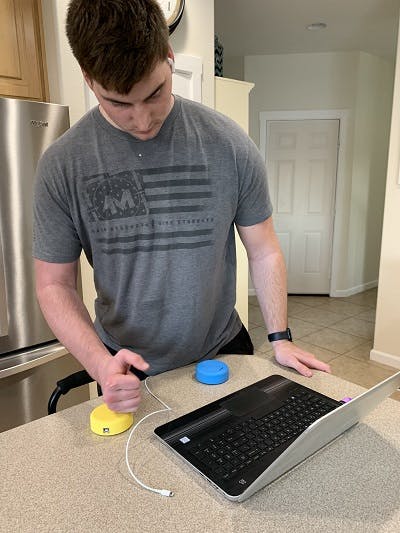Rehabilitation is an essential part of TBI recovery. Therefore, it’s important to find the home exercise program for traumatic brain injury most suitable for you. This can include a combination of physical and cognitive exercises, focused on skills specific to your recovery process. The goal is to find ways to stay engaged and motivated at home to promote recovery.
This article will discuss the importance of participating in a home exercise program for traumatic brain injury and the types of therapy exercises to include.
Use the links below to jump straight to any section:
- Creating a home exercise program for TBI
- Arm exercises
- Leg exercises
- Balance exercises
- Cognitive exercises
- Gamified neurorehabilitation devices
Creating a Home Exercise Program for Traumatic Brain Injury
Why Home Exercise Matters After TBI
When the brain sustains an injury, many of the neural pathways used to communicate with the rest of the body can become damaged. This can cause a variety of secondary effects, including cognitive and physical impairments, such as impaired short-term memory or hemiparesis (weakness on one side of the body).
Fortunately, the brain has the ability to rewire itself through neuroplasticity, allowing it to restore many affected functions. Neuroplasticity is best activated through high repetition of exercises, or massed practice. The more a task is practiced, the more the brain recognizes the importance of that task and rewires itself to restore related functions. Therefore, it’s imperative to find suitable exercises after brain injury for your ability level to best stimulate brain rewiring through neuroplasticity and regain functional skills.
Choosing the Right Exercises and Staying Motivated During Home Rehab for TBI
Your therapist is a great resource for rehabilitation exercises. However, after discharge, it can be harder to stay consistent with therapy. While your therapists often provide you with sheets of physical or cognitive exercises to do at home, it can be difficult to stay motivated. Studies have shown that individuals who solely use home exercise sheets are less likely to stay engaged in rehabilitation. Therefore, it is essential to try to make your home exercise program personalized and motivating for you.
One way to do this is to integrate your exercises into an activity that you already do each day. For example, if you are working on strengthening your arm, consider using your affected arm to put away cups in an overhead cabinet. This not only promotes the repetitive exercise needed to stimulate neuroplasticity, but also allows you to accomplish something you’d have to do regardless. Furthermore, combining your exercises with your daily activities allows for a seamless translation of skills learned exercising to real life tasks.
Other individuals find that they are able to accomplish more exercises during a certain part of the day. For example, some survivors like to work on upper body stretching exercises while they are in the shower. In this specific example, the heat from the shower can help to relax the muscles and relieve pain while stretching. Additionally, not only does regularly exercising while completing a normal daily activity make the most of your time, completing exercises at the same time each day helps to build a healthy habit of participating in your home program on a daily basis.
With an appropriately challenging and intrinsically motivating home therapy program, survivors won’t have to miss out on practice and can continue on with their TBI recovery.
Types of Exercises to Include in Your Home Therapy Program After TBI
Different sets of exercises can help TBI survivors both mentally and physically. Through regularly exercising, survivors can restore function, improve cognitive skills, build strength, regain balance, and practice flexibility. Participating in a home therapy program for TBI can also help improve the cardiovascular system. There are various types of cognitive and physical exercises you can try depending on which skills you want to target.
Exercises to consider in your home therapy program for traumatic brain injury include:
Arm Exercises for TBI Survivors To Try At Home
Pushing movement: For this exercise, place a water bottle on one side of the table within arm’s reach. Then hook your wrist on the outside of the water bottle and try to use your arm to push it across the table. Repeat this movement in the opposite direction for about 10 times with both arms. For a similar movement that can be easily integrated into your day, consider sitting at the table and working to wipe it with your affected arm. For an added challenge, add wrist weights.
Bicep Curls: Hold a water bottle in your hand and rest your arm by your side. Keep your elbow glued to your side and bring the water bottle up to your shoulder, flexing your bicep. Then bring your arm back down as slowly as you can (this also helps work your triceps) and repeat about 10 times on each side.
Shoulder flexion: Place a water bottle in your hand and rest your hand on your lap. Then try to lift your arm to a 90-degree angle in front of you. Make sure your arm is fully extended and leveled with your eye. Hold this position for about 5 seconds and bring your arm down slowly to your lap. Repeat about 10 times each arm. To try this exercise during your regular daily activities, use your affected arm to grab items out of an upper shelf in your refrigerator. Placing regularly used items on that shelf can increase your repetitions of this exercise throughout the day.
Leg Exercises for TBI Home Rehab

Hip abduction: Sit on a chair and hold one leg slightly above the floor. Kick this leg outward as if you were kicking a ball out of your way. Then kick your leg inward toward your midline. If you have young children, this could be made into a fun game by literally kicking a small ball across the floor with them.
Seated marching: While also sitting, lift your leg up towards your chest and hold for one second. Then let it down slowly and alternate between legs. For a challenge, try this standing up by stepping forward onto a small step stool, then back off, holding on to something to stabilize yourself if needed.
Quad exercises: For this exercise, lay on your back either on the floor or on a bed. First start with your knees bent and your feet flat on the floor. Then, straighten out your knees and bring your toes up towards the ceiling. This exercise may be challenging, so you can adapt it by starting with one leg if possible.
Balance Exercises for TBI Survivors at Home
Feet apart, arms out: First, stand with your feet shoulder width apart and extend your arms to the sides to form a T-shape. Look straight ahead and hold your position for about 30 seconds. To increase the challenge difficulty you can also try letting your arms rest down or folding them across your chest. This can be practiced during daily activities, such as during a television commercial or while waiting for something to warm up in the microwave.
Stand on one leg with support: Try to lift one leg while holding on to a support like the back of a chair or table. Hold for about 30 seconds and then switch to the opposite leg. Sustain longer until you feel comfortable enough to try to lift a leg without support.
Single step forward/backward: To practice this exercise, first stand still with your feet slightly apart. Then lift the right foot off the floor and take one step forward. Move the same foot back to its starting position and take a step backwards.
Cognitive Exercises for TBI Survivors at Home
Rhythm matching: This activity helps with attention and concentration. A caregiver or a loved one taps out a simple, two-step rhythm with their hand on a table, or hard surface, several times. The survivor then tries to match the rhythm.
Naming therapy: This exercise helps with memory. One way to do this is by having someone write down several categories, such as animals, food, and sports. Then, have the survivor try to remember either verbally or in writing as many items in that category as possible. This could also be made into a game (similar to Scattergories) to make it more motivating.
CT Cognitive Therapy App: This app offers access to over 100,000+ cognitive rehabilitation exercises that help with memory, critical thinking, and speech. This is a great way to motivate yourself and stimulate your brain in between therapy sessions.
Gamified Neurorehabilitation Devices to Use at Home
Exercise sheets can be tedious and discouraging. To stay engaged and motivated it helps to use fun therapy tools such as gamified neurorehabilitation devices.
FitMi, for example, is an interactive therapist-approved neurorehab device designed to improve mobility after brain injury. It provides full-body rehab exercises that target different muscle groups based on your ability level. The game nature of the program also helps to keep you motivated and accomplish a high amount of exercise repetition which unlocks harder exercises as you improve.
FitMi has reached tens of thousands of people across the country and helped many stay motivated at home.
FitMi Review for Traumatic Brain Injury Survivor
Check out this review from a 23 year old TBI survivor who endured a severe diffuse axonal injury:

“Bought the FitMi bundle for my 23 year old son who suffers from a severe DAI Brain Injury due to a multi-car accident in November 2020. After 6 months in a trauma center hospital and 2 months of inpatient therapy, and now a year later of vigorous outpatient therapy, we are watching his recovery of limited use of his right side arm/hand, leg/foot get stronger each week and we know it’s from daily use of the FitMi devices. His OT’s are impressed with the function of use in his hand, wrist and foot that are coming along so quickly.
Before we ordered these items he hardly tried to use his right hand, now he has a little bit of feeling coming back and more range of motion of turning his wrist along with using his fingers. He also practices moving his right foot on and off of the FitMi to get more motion in his right ankle and toes.
It’s a “game” changer when it comes to doing home therapy! He enjoys the music and the games, they keep him motivated to reach his goals in recovery. He was very active in sports and working prior to the accident and hopes to regain the usage of his right side again.
Thank you FitMi for helping my son during this change in life!”
FitMi helped this TBI survivor stay engaged and motivated throughout his recovery process at home. With consistent practice, he has been able to restore function of his right side, demonstrating the effectiveness of an at-home exercise program for TBI.
Taking Advantage of Home Exercise Programs after TBI
While survivors may receive therapy exercise worksheets from the hospital or other care facilities, it may not always be as effective at home. Rehabilitation consists of various types of exercises, but it also requires staying engaged and motivated.
Therefore, it’s important for survivors to personalize their exercises in order to create the best home exercise program for traumatic brain injury. Integrating exercises into your daily routine or using gamified therapy devices such as FitMi can be a great way to do this.
Through working on a combination of exercises at home and consistent practice, you can promote recovery and restore function after TBI more swiftly.










